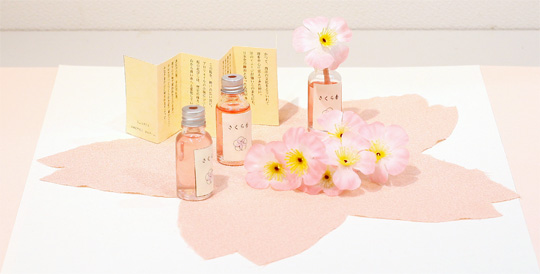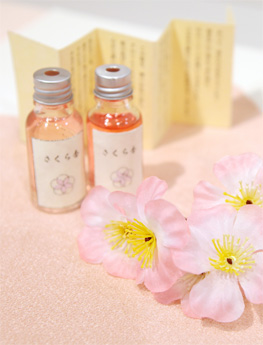

Our targets are middle-aged and elderly women who visit Suma and have an interest in history. As a souvenir of the trip, we offer three types of value. The first is a pleasant “healing aroma” that relieves feelings of tiredness for travelers and brings relaxation in everyday life. The second is an “aromatic reminder.” To begin with, our sense of smell and memory are said to be closely related. Suma has many cherry blossom viewing spots such as Suma-dera (a temple) and Sumaura Park. In addition, it is said that the battle of Ichino-tani raged in this area during the season of cherry blossoms, and the aroma of cherry blossoms will remind the users of their trips to Suma. The third is a “feeling for history through the changing colors of flowers.” The color of the artificial cherry flowers packaged with a small bottle of aroma oil is originally whitish, but we have designed the item so that the color turns slightly reddish as it soaks up the aroma oil in the bottle. Some people say that the term “red and white” in Japanese comes from the Genpei War. During this event, the Genji (or Minamoto) clan used a white flag while the Heike (or Taira) clan used a red flag. The two colors placed side-by-side came to be considered a symbol of peace without conflict. We hope that changing colors of cherry blossoms will evoke scenes from the battles and warriors of the Genpei War.
University of Marketing and Distribution Sciences: Nobutoshi Shimizu
We designed new souvenirs for the western part of Kobe City (Hyogo-ku, Nagata-ku, Suma-ku, Tarumi-ku, and Nishi-ku) where our university is based. In this area, nationally famous sightseeing spots are scarce.
For students who participated in the project, the CODE Souvenir project was the first task to tackle in a seminar that began during the second half of their second year. While their technical knowledge of marketing was not sufficient, they refined their ideas into product plans in creative ways, including by making use of on-site observation and research and analysis of competitive merchandise on the Internet.
The joint project with people from Nagoya had a great significance for us because it provided us with an opportunity to make a presentation to those who didn’t know much about Kobe. Our students struggled to learn how they should present product packages and slides to gain proper understanding from people in situations different from their own.